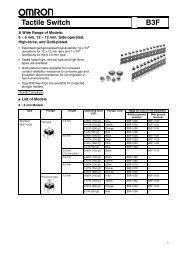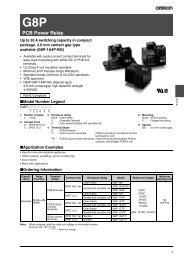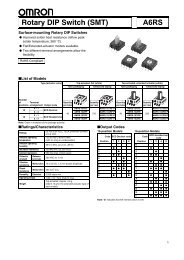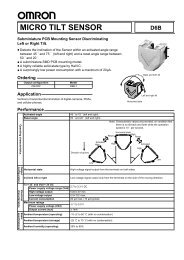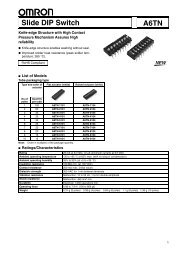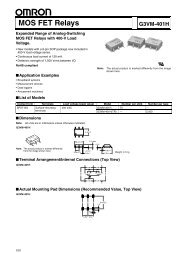VG2020 - Omron
VG2020 - Omron
VG2020 - Omron
You also want an ePaper? Increase the reach of your titles
YUMPU automatically turns print PDFs into web optimized ePapers that Google loves.
YOSHINORI<br />
SUZUKI<br />
AEC<br />
Current position: Managing Officer<br />
CEO & President, <strong>Omron</strong> Automotive Electronics Co., Ltd.<br />
Date of birth: April 27, 1952 (age 59)<br />
Words to live by: Benevolence, justice, courtesy, wisdom<br />
——— What is AEC’s approach to emerging markets?<br />
Suzuki (AEC): The standard practice among the world’s<br />
leading automakers is to develop local models based<br />
on a standardized global platform. However, we are<br />
beginning to see a gradual shift toward building a separate<br />
platform for each area. You heard from Mr. Tada,<br />
president of EMC, of the increasing uniformity in quality<br />
standards for commercial and consumer electronic<br />
components. For finished vehicles, however, the opposite<br />
applies, as there is a growing trend toward<br />
customizing specifications, price, and design to meet<br />
the needs of a particular area.<br />
Evolution of China’s Automobile<br />
Industry Unlike Other Emerging<br />
Markets<br />
——— What kind of strategies does AEC have in<br />
mind for the Chinese market?<br />
Suzuki (AEC): Amid this move toward customization,<br />
we need to approach China differently from other<br />
emerging markets in Asia. With the exception of China,<br />
there will be no significant changes in the industry’s<br />
main players. In China, many local manufacturers are<br />
becoming stronger, attributable in part to the government’s<br />
policy of providing assistance. On the demand<br />
side too, medium, large, and luxury cars are becoming<br />
increasingly popular in China, unlike in other emerging<br />
markets, which are about to enter a growth phase. This<br />
is why we are pursuing a policy of turning our production<br />
sites in China into autonomous bases that combine<br />
all stages, from development to production and sales.<br />
Even though local manufacturers are becoming bigger,<br />
they lack the know-how that enables cutting-edge<br />
global manufacturers to keep a firm grip on thousands,<br />
even tens of thousands, of parts, which they put together<br />
to make high-quality components. Conversely, this<br />
presents a business opportunity. Accordingly, we are<br />
cooperating with a variety of parts suppliers with a view<br />
to providing our local business partners in China with<br />
products that are easier to assemble. In addition to our<br />
electronic control units, these include seat belts,<br />
motors, and batteries.<br />
——— What is the basic strategy of the Healthcare<br />
Business for business expansion targeting consumers?<br />
Miyata (HCB): Under “Value Generation 2020,” our<br />
vision is to make testing and health management more<br />
familiar to the average consumer. The basic strategy<br />
of HCB comprises three courses of action to improve<br />
such familiarity.<br />
The first is to improve customer accessibility. This<br />
entails increasing customer sales channels, in other<br />
words, broadening sales so that <strong>Omron</strong> products are<br />
available for purchase around the world. The second<br />
is to improve the accessibility of equipment. HCB has<br />
created a market by offering home-use products that<br />
perform testing and measurement functions—such<br />
as taking blood pressure readings—that are normally<br />
carried out at medical facilities. Our aim is to contribute<br />
to the early detection and treatment of ailments by<br />
accelerating the development of safe, reasonably priced<br />
equipment that is easy to operate. This will lead to<br />
improved accessibility to testing, as it shifts from medical<br />
settings to the home and from large hospitals to<br />
local clinics. The third course of action is to improve<br />
the accessibility of data services. This involves making<br />
healthcare and medical services more accessible<br />
by means of information services that store and analyze<br />
readings.<br />
Aggressive Efforts to Broaden<br />
Sales Coverage<br />
——— What are HCB’s projections for emerging<br />
markets, and what growth strategy is it pursuing?<br />
Miyata (HCB): In the case of home medical equipment,<br />
the rule of thumb is that demand rises suddenly<br />
once GDP per capita exceeds $10,000. We have seen<br />
this happen in China, followed by Russia. Since the<br />
GDP per capita in Brazil was over $8,000 in the year<br />
ended March 31, 2010, we can expect to see growth<br />
in the near future. Higher incomes not only lead to<br />
economic development, but in emerging markets,<br />
they also result in expansion of the customer base.<br />
As incomes increase, meanwhile, lifestyles become<br />
more affluent, which is associated with an increase<br />
29<br />
[Special Feature 2] Interview with the Heads of Business Segments



